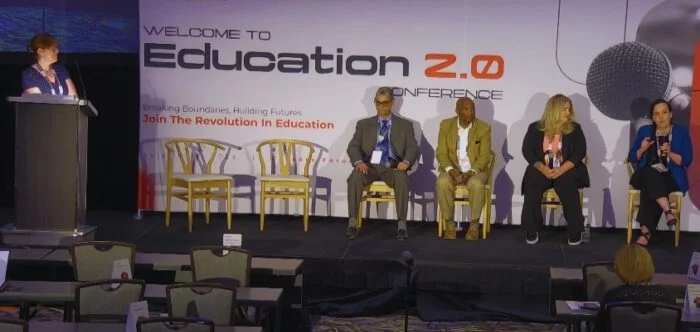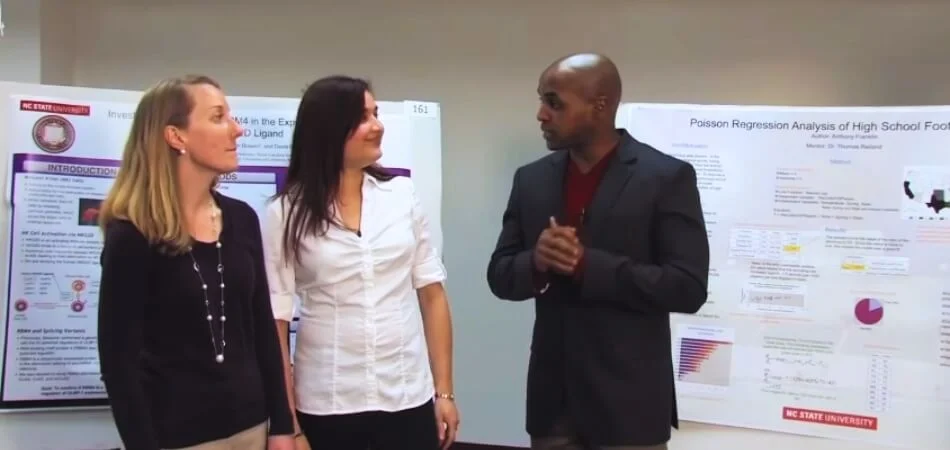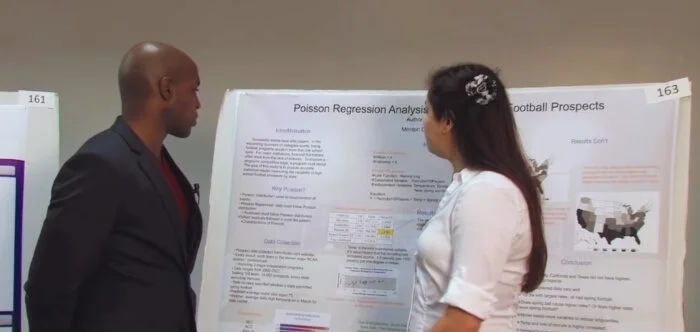Imagine stepping into a bustling conference hall where vibrant displays and inquisitive minds converge. This is the essence of a poster session at a conference: a dynamic and interactive presentation format that’s both engaging and informative. But what is a poster session at a conference?
It’s where researchers and presenters use visually compelling posters to showcase their research findings, innovative projects, or fresh ideas. These sessions transform traditional presentations into a more engaging experience, inviting attendees to interact directly with presenters, delve into the content, and ask probing questions.
To delve deeper into the world of poster sessions and discover their impact on knowledge sharing and networking, continue reading our comprehensive exploration of this exciting conference feature.
What Happens at a Conference Sessions?
At a conference, a tapestry of knowledge unfolds through various sessions, each a unique opportunity for learning and networking. These sessions, ranging from keynote speeches to panel discussions, cater to diverse interests and fields. Attendees are immersed in an environment ripe for professional growth and idea exchange.
During conference sessions, especially in an event with top-notch keynote speakers, experts share insights, presenting cutting-edge research and industry advancements. Interactive elements like Q&A segments enrich these sessions, promoting lively discussions and deeper understanding. Networking breaks intersperse, offering chances to connect with peers and thought leaders.
Each session acts as a catalyst for innovation, inspiring attendees to think creatively and collaborate. The diversity of topics ensures a broad spectrum of knowledge is available for exploration. Overall, conference sessions are pivotal in shaping professional landscapes, encouraging learning, and building meaningful connections in various fields.
What is a Poster Session at a Conference?
In conferences, a poster session stands out as a vibrant and interactive component. It’s where knowledge and visuals merge to create an engaging learning environment. These sessions are integral to many academic and professional gatherings, offering a unique platform for idea exchange.
A poster session at a conference is a dynamic and collaborative event where presenters display their research or projects visually. Through posters, complex ideas are distilled into engaging, easy-to-digest formats, often accompanied by graphics and data. This format allows for a more intimate and interactive discussion between presenters and attendees. As attendees navigate through the posters, they engage in one-on-one or small group conversations with the researchers.
These sessions foster a more informal yet deeply informative atmosphere compared to traditional presentations. Presenters get the opportunity to receive direct feedback and questions from an interested audience. Attendees, on the other hand, benefit from personalized explanations and can delve deeper into topics of interest. Such interactions often spark new ideas, collaborations, and a deeper understanding of the subject matter.
Poster sessions at conferences serve as a melting pot of ideas, where visual communication enhances the sharing of knowledge. They are crucial for nurturing collaboration, networking, and the exchange of ideas in a more relaxed yet intellectually stimulating environment. These sessions not only disseminate information but also inspire continued discussion and innovation long after the conference concludes.
Types of Poster Sessions at a Conference
Poster sessions at conferences are not a one-size-fits-all affair; they come in various formats, each tailored to different needs and objectives. These sessions are vital for encouraging communication and sharing knowledge in a visual and interactive manner. Attendees and presenters can maximize the conference experience by understanding the different types of poster sessions.
Research-Based Poster Sessions
These sessions focus on presenting original research findings. Presenters use posters to summarize their methodology, data, and conclusions succinctly. This format is ideal for showcasing new scientific or academic discoveries. Attendees get the chance to engage directly with the researchers, asking questions and discussing the implications of the findings.
Project Showcase Poster Sessions
Here, the spotlight is on practical projects, innovations, or implementations. These sessions are common in industry conferences where practical applications are key. Presenters illustrate the project’s objectives, development process, and outcomes. This type encourages networking among professionals interested in similar projects or applications.
Educational Poster Sessions
Educational poster sessions are designed to inform and teach. They often cover best practices, instructional techniques, or educational research. Presenters use posters to break down complex educational concepts into understandable segments. This format is particularly beneficial for educators and those involved in curriculum development.
Thematic Poster Sessions
Thematic sessions group posters by specific themes or topics. This arrangement allows attendees to explore a broad spectrum of ideas within a particular field. It’s a great way for presenters to compare and contrast their work with others in the same area. Thematic sessions also facilitate focused discussions among participants with similar interests.
Poster sessions can greatly enhance the conference experience if you understand the various types. Whether you’re a presenter or an attendee, knowing what to expect and how to engage with each type of session can lead to more fruitful interactions and learning opportunities. These varied formats ensure that conferences remain dynamic platforms for knowledge exchange and professional growth.
Why Should You Attend the Poster Session of a Conference?
Attending the poster session of a conference is more than just an academic ritual; it’s a gateway to a world of interactive learning and networking. These sessions offer unique opportunities that traditional presentations cannot match. They are a blend of visual appeal, direct communication, and collaborative learning.
Direct Interaction with Experts
Poster sessions provide a rare opportunity to interact directly with experts and researchers. You can ask specific questions, clarify doubts, and gain deeper insights into the research. Such face-to-face interactions often lead to more meaningful understandings of complex topics. They also allow for immediate feedback and detailed explanations that are not possible in larger, more formal sessions.
Networking Opportunities
These sessions are fertile grounds for networking with peers, mentors, and leaders in your field. Engaging with various presenters and attendees opens doors to future collaborations and professional relationships. Such interactions often lead to the exchange of ideas, knowledge, and contacts. Networking in this informal setting can be more effective than through structured networking events.
Learning Beyond Your Field
Attending poster sessions exposes you to a wide array of topics, some even beyond your immediate field of interest. This broad exposure can spark new ideas, perspectives, and interests. Such a diverse learning environment encourages interdisciplinary thinking and innovation. It’s an opportunity to explore and understand emerging trends and methodologies across various disciplines.
The poster session of a conference is an invaluable part of the academic and professional journey. It’s where learning is not just about listening but engaging, questioning, and connecting. Whether you’re looking to deepen your knowledge, expand your network, or explore new fields, these sessions are a must-attend. They embody the essence of collaborative learning and intellectual exchange.
How to Present Your Own Poster in a Conference Postering Session?
Presenting your poster in a conference poster session is an art that combines clarity, engagement, and effective communication. It’s an opportunity to showcase your work, connect with others, and gain valuable feedback. Mastering this skill can significantly enhance your professional profile and academic journey.
Step 1: Designing Your Poster
Begin by creating a visually appealing and informative poster. Use clear, concise language and visually engaging graphs or images. Your poster should effectively summarize your research or project, highlighting key points, methods, and conclusions.
Step 2: Preparing Your Pitch
Craft a brief, engaging summary of your work to share with attendees. This pitch should be clear, concise, and tailored to a general audience. Practice it to ensure you’re confident and can adapt it to different types of attendees.
Step 3: Engaging with Attendees
Be proactive in engaging attendees. Invite them to view your poster, and be ready to answer questions and discuss your work. Listen to their feedback and questions, as these can offer new perspectives and insights.
Presenting a poster effectively requires careful planning, clear communication, and active engagement with your audience. Your ability to convey your research compellingly and interact with attendees can greatly impact your experience’s success. This is your chance to make a lasting impression, so embrace it with enthusiasm and professionalism.
Final Words
It is clear that poster sessions are crucial for academic and professional advancement as outlined in “What is a poster session at a conference?”. They offer unique platforms for presenting research, fostering direct interaction with experts, and opening up vast networking opportunities.
The diversity in poster session formats, including research-based, project showcase, educational, and thematic, caters to a wide range of interests and fields. Attending these sessions not only broadens one’s knowledge but also encourages interdisciplinary thinking and innovation. When it comes to presenting, the key steps include designing an informative poster, preparing an engaging pitch, and proactively engaging with attendees.
The success of a poster session hinges on clear communication and the ability to connect with the audience, making it an invaluable experience for both presenters and attendees. This dynamic exchange of ideas not only enhances learning but also paves the way for future collaborations and professional growth.








